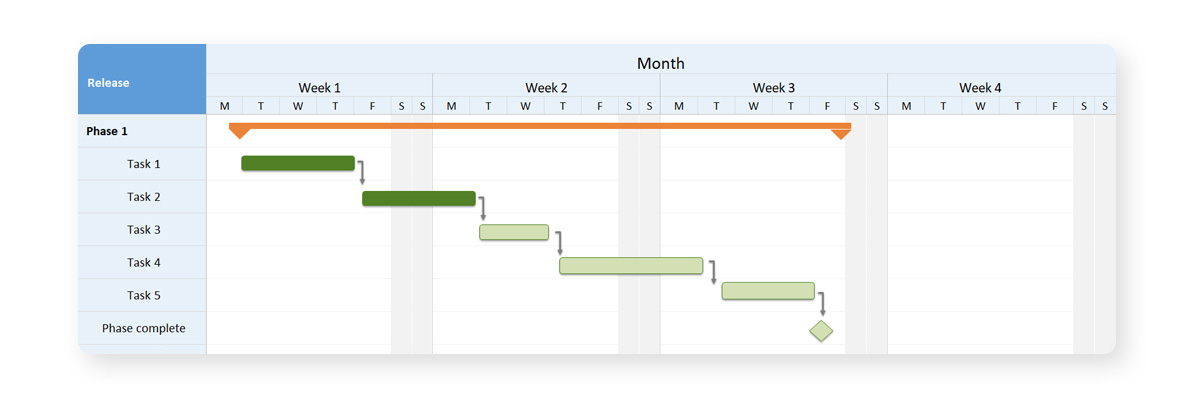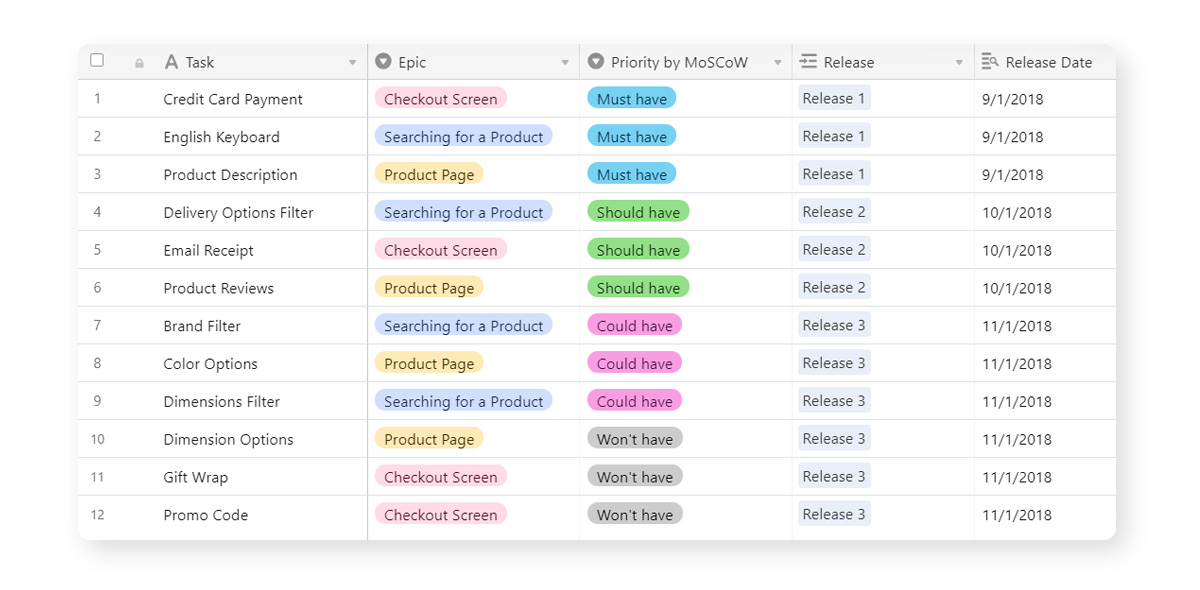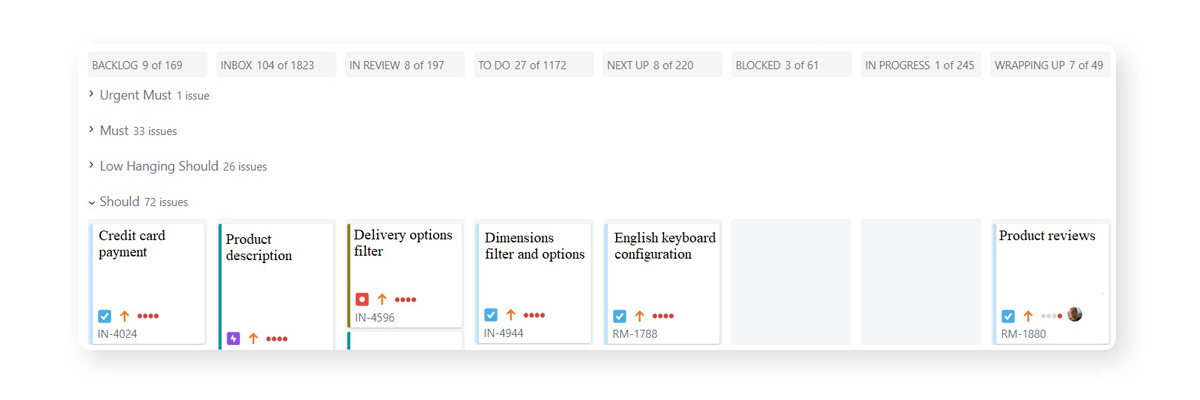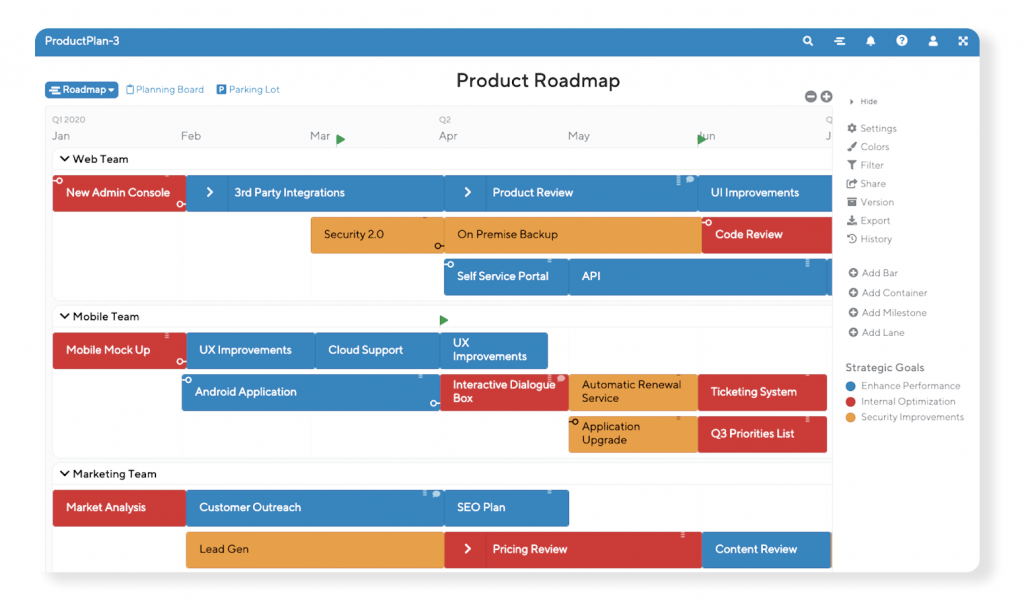Product Roadmap, how to create it and use it?
A product strategy flows from the vision and directs the pipeline through milestones. A roadmap helps product owners align the workflow with the strategy. This tutorial will explain the role of this document and how you can use it to execute the journey from an idea to a working digital product.
What is a product roadmap?
A product roadmap is a strategic plan that displays workflow and milestones of the pipeline. It clarifies the product strategy implementation through milestones – epics and features. The scope usually includes engineering, marketing, hiring, and so on. The product roadmap allows you to establish and track the order in which things are to be worked on.
A product roadmap is a high-level plan that displays workflow and milestones of a strategy-based pipeline
It is vital to differentiate roadmapping from lower-level planning approaches like a backlog. The product backlog is a task board for a product team. It contains information about current iteration, tasks for the next iteration, and icebox. Here, the focus is made on technical aspects of the pipeline. The product roadmap is a strategic planning tool with a focus on user needs. It sets out the main job to be done within the product development. In some cases, the backlog may be a part of the roadmap.
What is a product roadmap for?
Antoine de Saint-Exupéry said that a goal without a plan is just a wish. Roadmapping allows you to plan things that will contribute to your pipeline. The agile product roadmap is a living guide for the team during the development journey. With it, you know where to move and when to pivot if you’re heading in the wrong direction. Here are some other benefits or reasons to use this high-level plan:
- Building a development team. The product roadmap process provides data transparency within the team. Also, the team members get shared ownership of the strategy.
- Goal setting. The plan lets you focus on achievable goals and avoid scattering. Thus, a winning product strategy rests on specific areas with the best performance. You can point out realistic objectives and recognize weak points from the outset.
- Information sharing. A good product roadmap is a concise yet content-rich data source. It gives a clear vision of where the workflow is heading. Also, it serves as an adequate source of data for clients and stakeholders. You can use the roadmap as a framework for setting partnership relations. The document can also be a bargaining chip in negotiations.
- Driving resource efficiency. One of the product roadmap benefits is workflow prioritization. This, in turn, allows for enhancing the efficiency of resource usage. Knowing the order of features to implement lets you distribute your investments properly.
- Cross-functional planning. Creating a product roadmap is not about one focus area. It involves cross-functional planning. The roadmap incorporates all the supplementary areas required to build a product. The objectives of engineering, design and other areas are to be recognized in the roadmap. This provides a long-term perspective on the pipeline.
Roadmapping gives you evidence of strategy. You should not take it as just a list of tasks to be done. It is a plan based on product vision and strategy that lets you define the tactic for product development.
Product roadmap structure
The product roadmap format typically looks similar to a Gantt chart but differs in the gist. Gantt charts assume a linear delivery of tasks. And they are directly dependent on one another. In most cases, this type of document excludes any schedule modification. A product roadmap is an agile tool. Hence, it’s mutable and assumes both direct dependency and loose coupling among tasks.
Roadmaps can have many structures and forms due to the scope and purpose. Simple formats may contain lots of information. They are useful to provide the big picture. Conversely, roadmaps with complex structures are more informative despite the sparse context. They also provide the full picture and map out many details. Both simple and complex formats mostly have a two-axis structure:
- A horizontal axis is responsible for timing. The product roadmap extends to the right for a certain time period.

In no-dates roadmaps, there is no specific schedule. Instead, you rank tasks by their state like Next Up, Prepare, Done, etc.

- A vertical axis usually depicts product roadmap prioritization. Here are some approaches you can use for that.
Top-to-bottom: the most important or valuable task/ideas are always on top.
Feature-driven: the focus is to be made on building and releasing features. You classify tasks as Core, Actual, Augmented, and so on. This approach suits best to mature products with a stable market.
MoSCoW: you classify tasks according to their importance. The categories include Must-haves, Should-haves, Could-haves, and Won’t-haves.

Timeline and no-dates product roadmaps
Timing is an integral element of the product roadmap and strategy or is it? At Railsware we opt for both timeline and no-dates planning. The choice usually depends on product goals.
Roadmaps without deadlines
The timeless approach is useful for early-stage products. No-date product roadmaps provide flexibility to frequent updates. Your progress is mostly defined by finding a footing for further development. Strict long-term planning is no fit here.
If you are in search of product-market fit and first users, deadlines are not an option. Instead, you may use different state categories like IN PROGRESS, BLOCKED, TO DO, etc. Here is how we do that.

Roadmaps with deadlines
The majority of product roadmaps are time-based. That’s what the guys from Roadmunk, a roadmapping tool, claim. Indeed, products with a focus on evolution, marketing, and sales need pinpoint planning. Besides, deadlines show the long-term vision of your activities.
After the go-to-market stage, your product roadmap agenda should rely on dates. Scheduling is required for a proper growth strategy. First, you may operate deadlines on a quarterly or monthly basis. Later on, your timing can have a longer-term horizon. Take a look at the following example of a time-based product roadmap provided by another planning tool – ProductPlan.

How to build a product roadmap?
I don’t want you to do roadmapping like this:
- Choose a tool
- Lay out the timeline
- Prioritize epics and features
Our product roadmap guide will help you launch and execute product development. So, you need to investigate the content for the roadmap first.
For this to not be a giant post, you can visit Railsware's blog to check out the rest of the article and all the steps for building a roadmap. Thanks for reading and I'm open for feedback of course! :)
